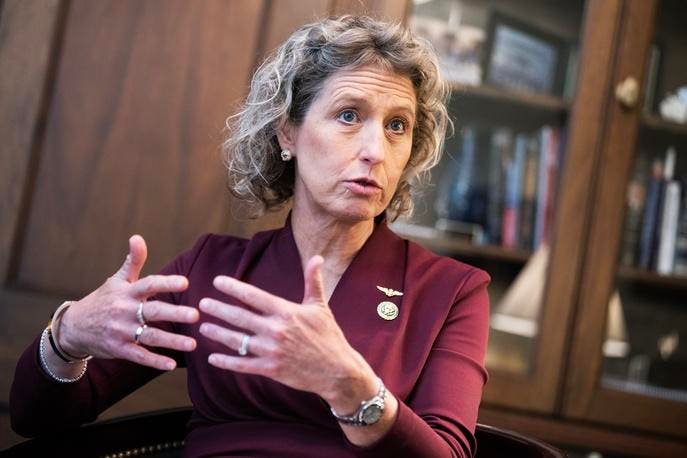As the world transitions into the post-Covid era, the aftermath of this unprecedented global event serves as a cautionary tale of the many intricacies that lie dormant in supply chains, waiting to be unleashed at even the most subtle signs of disruption and geopolitical tension.
As witnessed during the pandemic, China’s prominence in global manufacturing is a force to be reckoned with due to its ability to cripple the American economy with staggering volatility and disruption. Additionally, China continues to outpace the U.S. in its STEM workforce.
Hence, an increased focus on the U.S. semiconductor supply chain has been brought to light as policy makers have become more attuned to approaches to ensure economic resilience and national security as seen with recent legislation such as the Executive Order on America’s Supply Chains, the enactment of the CHIPS and Science Act, and latest government restrictions on AI exports to China.
“One of the greatest national security threats we face today is China’s chokehold on our defense industrial base,” said Congresswoman Kiggans. “Semiconductors are an integral part of our daily life and the backbone of America’s national security. With Communist China ramping up its aggression around Taiwan — which currently produces over 90 percent of the world’s advanced chips — there’s no time to waste in boosting domestic chip production”, also said Rep. Michael McCaul (TX-10) in a recent statement.
Since the enactment of the CHIPS and Science Act in 2022, semiconductor fab construction projects have begun in various states, boosted by $200 billion dollars in private investments to strengthen domestic manufacturing capacity. Yet, semiconductor construction projects under the CHIPS Act are especially vulnerable to stringent federal regulations for new domestic manufacturing projects, thereby slowing the development and construction of domestic fabs.
“Last year Congress made historic investments in our microchip industry that are supercharging innovation in San Diego and around the country,” said Representative Peters. “Unfortunately, permitting regulations are delaying projects that are already under construction just because they receive CHIPS Act funding.”
Such federal regulations is the National Environmental Policy Act (NEPA) of 1969, which require environmental reviews that span an average 4.5 years, plus the additional average two years needed to fully construct a new greenfield fab facility.
NEPA proposals can fall into one of three categories for environmental analysis: a categorical exclusion, an environmental assessment, or an environmental impact statement.
According to the Center for Strategic and International Studies, 90% of NEPA proposals typically fall under the categorical exclusion category where such projects would be deemed to have minimal environmental impact, thus being exempt from review.
However, the construction of greenfield semiconductor fabs does not customarily qualify for any categorical exclusions. Therefore, an environmental assessment (EA) is conducted to determine if such a project will have a significant impact to the environment. And if said project is determined to have significant environmental impact, a federal agency must then draft an environmental impact statement (EIS) for public review.
On that account, the U.S. government must get in front of these bottlenecks to encourage more domestic fab construction and mitigate the threats of delayed semiconductor manufacturing projects already underway, even those that have already received environmental permits to proceed with construction under federal and state law.
“Unfortunately, federal bureaucracy is holding up critical projects started by the CHIPS Act while the Chinese Communist Party spends billions of dollars to become the world’s leading producer of advanced semiconductors.” said Congresswoman Kiggans.
Introducing the Building Chips in America Act of 2023
Earlier this month, Congresswoman Jen Kiggans (VA-02), along with Congressman Scott Peters (CA-50), House Foreign Affairs Committee Chairman Michael McCaul (TX-10), Congressman Brandon Williams (NY-22), and Congressman Colin Allred (TX-32), introduced the Building Chips In America Act.
The legislation, which was introduced in the Senate by Senators Mark Kelly (D-AZ), Todd Young (R-IN), Bill Hagerty (R-TN), and Sherrod Brown (D-OH), will ensure federal environmental reviews are completed in a timely manner for semiconductor projects by streamlining approval for projects currently under construction and others that could be delayed, and by providing the Secretary of Commerce greater tools to more effectively and efficiently carry out reviews, according to a press secretary for Congresswoman Jen Kiggans.
Moreover, the Building Chips In America Act of 2023 will maximize the opportunity to bring microchip manufacturing back to America by establishing the Department of Commerce as the lead federal agency to carry out NEPA reviews for any CHIPS Act project deemed to be a major federal action. This will ensure the federal government more effectively implements the CHIPS and Science Act and maximizes its potential to boost domestic microchip manufacturing, strengthen domestic supply chains, lower costs, and improve national security.
“I’m proud to introduce this bipartisan legislation to cut red tape and empower America’s domestic manufacturers to succeed for the sake of our national security and our economy!” said Congresswoman Kiggans.
What’s New Under The Building Chips In America Act?
Under this new legislation, certain CHIPS Act projects will no longer be considered a major federal action subject to NEPA review. These projects include:
- CHIPS Act projects that have have already received necessary federal and state permits and begun construction and any activity relating to the construction, expansion, or modernization of a facility for a project that started before the date federal financial assistance was provided.
- Expansion of existing sites that do not more that double the size of the site. This includes a facility that is on or adjacent to a site that is owned or leased by an entity to which Federal assistance was provided and substantial similar construction, expansion, or modernization has already been carried out and will not more than double existing developed acreage or supporting infrastructure.
- Projects that are required to undergo a state-level environmental review, which is as stringent as NEPA. This means that the Secretary of Commerce can now determine that the laws and regulations governing environmental reviews in the State in which the facility is or will be located are functionally equivalent to NEPA requirements.
- Projects where the federal assistance does not account for more than 15% of the cost of the facility. This includes any federal financial assistance in the form of a loan or loan guarantee.
Categorical Exclusions Under The Building Chips In America Act
Additionally, the following categorical exclusions are established for the National Institute of Standards and Technology (NIST) and are available for use by the Secretary of Commerce:
Categorical exclusion 17.04.d (in the document entitled ‘EDA Program 18 to Implement the National Environmental Policy Act of 1969 and Other Federal Environmental Mandates As Required’)
Acquisition of machinery and equipment (M&E) unless they require applications for or amendments to existing air, water or solid waste permits.
Categorical exclusion A9 in Appendix A to subpart D of part 1021 of title 10, CFR
Information gathering (including, but not limited to, literature surveys, inventories, site visits, and audits), data analysis (including, but not limited to, computer modeling), document preparation (including, but not limited to, conceptual design, feasibility studies, and analytical energy supply and demand studies), and information dissemination (including, but not limited to, document publication and distribution, and classroom training and informational programs), but not including site characterization or environmental monitoring.
Categorical exclusions B1.24, B1.31, B2.5, and B5.1 in Appendix B to subpart D of part 1021 of title 10, CFR
Property transfers, installation or relocation of machinery and equipment, facility safety and environmental improvements, and actions to conserve energy or water.
Categorical exclusions described in paragraphs (4) and (13) of section 50.19(b) of title 24, CFR
Public services that will not have a physical impact or result in any physical changes, including but not limited to services concerned with employment, crime prevention, child care, health, drug abuse, education, counseling, energy conservation and welfare or recreational needs.
Operating costs including maintenance, security, operation, utilities, furnishings, equipment, supplies, staff training and recruitment and other incidental costs; however, in the case of equipment, compliance with § 50.4(b)(1) is required.
Categorical exclusion (c)(1) in Appendix B to part 651 of title 32, CFR
Construction of an addition to an existing structure or new construction on a previously undisturbed site if the area to be disturbed has no more than 5.0 cumulative acres of new surface disturbance. This does not include construction of facilities for the transportation, distribution, use, storage, treatment, and disposal of solid waste, medical waste, and hazardous waste (REC required).
Categorical exclusions A2.3.8 and A2.3.14 in Appendix B to part 989 of title 32, CFR
Performing interior and exterior construction within the 5-foot line of a building without changing the land use of the existing building.
Installing on previously developed land, equipment that does not substantially alter land use (i.e., land use of more than one acre). This includes outgrants to private lessees for similar construction.
Other categorical exclusions
Any other categorical exclusion adopted by another Federal agency that the Secretary of Commerce determines would accelerate the completion of a covered activity if the categorical exclusion were available to the Secretary of Commerce.
Overcoming Permitting Challenges Is Just A Start
As of 2023, over 50 new semiconductor ecosystems projects have been announced across the U.S. which include new fab construction projects, expansions of existing sites, and facilities that supply the equipment and materials that are used to manufacture chips, according to the Semiconductor Industry Association.
While this new legislation will contribute towards the advancement of cutting-edge innovation and enhancement of U.S. national security, chipmakers will still need to remain vigilant in proactively navigating supply chain complexities, such as the recent labor shortages reported by Taiwan Semiconductor Manufacturing Co. (TSMC) in a recent earnings call.
TMSC’s $40 billion investment in new fab facilities located in Phoenix, Arizona is expected to create 4,500 jobs. However, TSMC is currently grappling with production delays until 2025 due to a skilled worker shortage, while its shares fell more than 3% last Friday with a 10% decrease in 2023 sales, according CNN Business. The chipmaker is planning to send trained technicians from Taiwan to train local workers ahead of production.
Nonetheless, the move by the U.S. government to support billions in domestic manufacturing investments by streamlining federal reviews under the Building Chips In America Act is a critical step forward towards national security and advancing the American economy.
“Standing with Rep. Kiggans to deliver this victory for our districts is an honor and privilege,” said Rep. Brandon Williams (NY-22). “This Act will provide short-term relief to local and future projects, by eliminating the redundancies and regulatory requirements set under NEPA which would force projects like Micron to undergo environmental reviews that are already required by federal, state, and local mandates.”
Read the full article here










